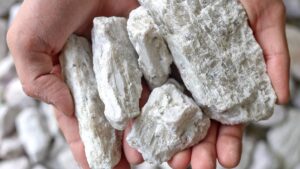Can the US become a force in lithium?

The USA has just one operating lithium mine, but that could change as exploration accelerates. Pic: Getty Images
- The focus of the US’ critical minerals push has largely been rare earths
- Yet the country is a tiny producer of lithium and is import-dependent
- While weak pricing has slowed development, the situation is likely to change in the coming years
The US is not currently a major player in the lithium market. But with rising demand and a friendly permitting environment, that will likely change.
Albemarle Corporation’s Silver Peak lithium mine in Nevada is currently the US’ only lithium producer.
S&P Global Commodity Insights principal analyst, future energy metals research Alice Yu told a recent webinar that around 90% of the US’ lithium needs, including finished or semi-finished goods, were met through indirect imports last year.
China only accounts for around 1.2% of US lithium imports, with battery cathodes and precursors largely imported from South Korea and Japan, which are largely produced using refined lithium from China.
While the US and Japan have signed a trade deal, Yu pointed out that tariffs were still higher than under the previous administration.
“Some players are looking at investing in US-based production capacity for precursors, cathodes and batteries, but some of those investments are currently parked because of concerns around downgrades to (the) US EV outlook,” she said.
“And if they were to slow, then there’s less of an urgency or the need to shift capacities to the US.”
Chariot Corporation (ASX:CC9) managing director Shanthar Pathmanathan, whose company has both hard rock and clay-hosted projects in the US, told Stockhead the impetus to produce more lithium domestically would ramp up once planned battery capacity in the US was operational.
“Because it doesn’t produce a single battery, there’s no palpable need for lithium in-country,” he said.
“But soon as those batteries start rolling off the production line, people are going to go, ‘hang on, these guys are shipping the lithium in from China. Why don’t we build a refinery?’ And Tesla’s actually building that refinery right now.
“I think until the production of lithium batteries happens, then people won’t have that same urgency in their head.”
EV sales slowing but still growing
“The concern over US EV demand is very real,” Yu said.
According to Rho Motion, the North American EV market has grown by just 2% so far this year, lagging Europe, which has grown by 30%.
While US President Donald Trump has been keen to boost domestic minerals production, a large focus of that push has been rare earths.
“Defence and security-led priorities are now what’s driving US critical minerals policies, and that’s a marked shift from the previous energy transition priorities,” Yu said.
“The latest budget bill has slashed federal support for EVs and the support for the production of batteries and critical minerals will also end earlier than before.
“We expect US EV demand to drop because of higher cost from the end of the tax credits by September at a time when consumers are still highly sensitive to the support and as the US EV industry is still scaling up.
“US EV costs will also rise on higher cost of imported EVs, battery components and likely critical minerals that go into them.”
Last week, the US Department of Energy (DOE) announced its intent to issue notices of funding opportunities totalling nearly US$1 billion to advance and scale mining, processing, and manufacturing technologies across key stages of the critical minerals and materials supply chains.
While several of the funding initiatives are focused on rare earths, there was up to US$500 million to expand US critical mineral and materials processing, including lithium, and derivative battery manufacturing and recycling.
There was also up to US$50 million of funding for technology, including direct lithium extraction and separation.
Asian players keen to invest
Chariot is in talks with potential Chinese partners, both for its projects in Nigeria and the US.
“One company that we are talking to is developing, through a subsidiary, a battery plant in America,” Pathmanathan said.
“I think what people are going to find is that these US-China trade talks are going to emanate into something a bit different than what was initially quite hostile, where the Chinese won’t give up any technology.
“However, because it’s a big business opportunity, they will look to build manufacturing capacity in America.
“I think that solves two problems. It gets around the tariff, and secondly, it’s still consistent with China’s concept that they’re off to a lead in the race, and they don’t want to give up that lead by sharing the technology, but they can just go and set up factories there.”
Last month, Anson Resources (ASX:ASN) announced a memorandum of understanding with South Korea’s POSCO to develop a DLE demonstration plant at its Green River project in Utah.
Anson executive chairman Bruce Richardson said the company first met POSCO in 2018 and reconnected last year.
“They had to find new sources of material in the United States, or at least, something that didn’t involve going through China,” he said in an interview last month.
POSCO is conducting test work on a sample from Green River with a view to make a decision on whether to proceed by the end of the year.
Projects advancing
Yu said the weak pricing in lithium had slowed the development of US mines and the broader battery supply chain.
“The government needs to add more incentives to boost investment for critical minerals where prices are low and where market fundamentals are weak,” she said.
Earlier this week, spodumene prices hit US$1000 per tonne, a 2025 high, as the market continues to digest the fallout of mine suspensions in China.
The US has two permitted lithium projects, both in Nevada.
Lithium Americas’ Thacker Pass, in which US carmaker GM holds a minority share, is under construction though it won’t achieve first production until late 2027 at the earliest.
The other project to be permitted is Ioneer’s (ASX:INR) Rhyolite Ridge, which is subject to a partnering process before a final investment decision is made.
In addition, a number of lithium projects, including Jindalee Lithium’s (ASX:JLL) McDermitt project in Oregon, have been designated as FAST-41 Transparency Projects, which can speed up permitting.
Piedmont Lithium, which is working towards a merger with Sayona Mining, is advancing its fully integrated Carolina mine and hydroxide facility in North Carolina.
In the DLE space, Albemarle, Standard Lithium, Equinor, ExxonMobil and EnergyX, which recently acquired Pantera Lithium’s (ASX:PFE) Smackover project, are active in Arkansas.
Anson raised $5 million this week to continue to advance Green River and is working towards a final investment decision next year.
Exploration increasing
Pathmanathan believes with the improving regulatory environment in the US, exploration will increase and resources will grow.
“If you look at Thacker Pass, if you look at Jindalee, and if you look at our property in the McDermott Caldera, that’s probably the number one area to focus on – that, to me, is the Saudi Arabia of lithium sitting in the US,” he said.
He added that the improvements in permitting in the US were a positive for the company and it was keen to engage with the government.
“To get these projects permitted is a high priority, and then advancing exploration at each of these projects is also high priority,” he said.
Meanwhile, Astute Metals (ASX:ASE) is advancing its Red Mountain lithium project in Nevada and kicked off a drilling campaign on Monday, which will feed into a maiden resource to be released before the end of the year.
Despite its lack of production, the US already has the fifth-largest reserves of lithium globally and the third-largest measured and indicated resources, according to the US Geological Survey.
“Last year, US exploration spending in lithium ranked the third highest globally, and that’s well ahead of bigger producers today like Argentina, Brazil and Chile,” Yu said.
“We know that exploration takes place years and decades before production, so the very strong US exploration in lithium in 2024 will bode very well for the outlook.”
At Stockhead, we tell it like it is. While Anson Resources and Chariot Corporation are Stockhead advertisers, they did not sponsor this article.
Related Topics

UNLOCK INSIGHTS
Discover the untold stories of emerging ASX stocks.
Daily news and expert analysis, it's free to subscribe.
By proceeding, you confirm you understand that we handle personal information in accordance with our Privacy Policy.








